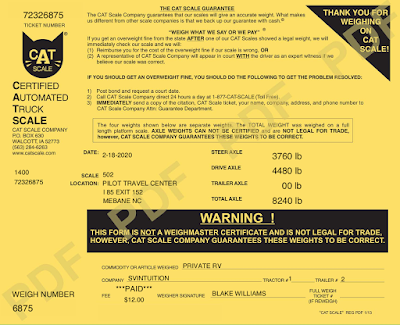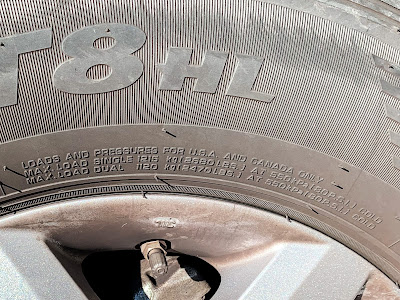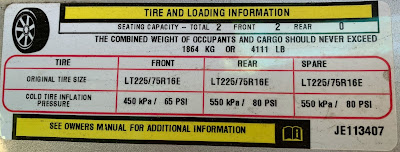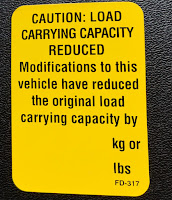Looking for projects to do in the off season we decided to see if we could learn more about our trusty Lexor. We wondered if it, like us, might have taken on too much weight over the holidays.
Here’s the logic we used to figure out if we are within the safe loading limits of our van. By the way, our van is a 2018 Pleasure-Way Lexor TS built out on a 2018 RAM ProMaster 3500 cargo van chassis.
Disclaimer – note that I’m just a user, not an automotive engineer. Don’t just take my word for it, do your own research too.
There are lots of stickers and abbreviations like OCCC, GVWR, GCWR, and GAWR to decode.
OCCC sounds like one that makes sense, it stands for Occupant and Cargo Carrying Capacity*. A yellow sticker on the passenger side door jam shows this to be 1,510 lbs. Figuring out if we are under 1,510 lbs. would involve weighing everyone, and everything, that will be in the van. Even I know better than to ask my wife how much she weighs, so that method is just not going to work for us. If you go this way, don’t forget to add in the weight of liquids in the fuel, water, holding tanks and add the tongue weight if you are pulling a trailer.
A simpler method is to actually weigh the van with us, and our stuff, in it. Then we can compare that to the maximum safe weight and know if we are okay.
Opting for simplicity, we went to a Pilot gas station and weighed the van on a CAT scale. They emailed us our 8,240 lb. weight as we were driving off the scale. It only cost $12 and was easy to do. If you haven’t ever weighed your vehicle, check out this excellent Fit RV video on how to use a CAT scale.
So how much can the van safely weigh? That number is the GVWR or Gross Vehicle Weight Rating. This number is 9,350 lbs for our van. GVWR can be found on this sticker on the driver side door jam.
The actual weight from the scale of 8,240 lbs is less than the 9,350 maximum weight allowable (GVWR) by 1,110 lbs., so we feel good about the weight.
But what about all of those other abbreviations? Are there other things we need to consider? Let’s look at it from the top down.
We’ve considered how much the entire van can weigh in the GVWR of 9,350.
Axles
Moving closer to the ground, there are specific weight limits for each axle. These are called GAWR for Gross Axle Weight Rating. These are also found on the driver door sticker.
Note that the Pleasure-Way manual shows all of these weight limits in an easier to read format.
One nice thing about the CAT scale is they provide weights for each axle, so we can compare to the weight limits.
| GAWR Front | 4,629 |
| Actual Front | 3,760 |
| Max. – Act. | 869 |
| GAWR Rear | 5,291 |
| Actual Rear | 4,480 |
| Max. – Act. | 811 |
Our actual weights are less than the GAWR limits, so we’re safe on the axles too.
Tires
Tires also have load limits. These are embossed on the tire sidewall. There are two ratings; “max load single” and “max load double.” The double rating is for vehicles with dual rear wheels. Since our ProMaster doesn’t have dual rear wheels, we use the Max load single rating of 2,680 lbs.
Our Lexor came with the original equipment Nexen Roadian CT8 HL tires.
We don’t have easy access to a scale that weighs each tire individually, so we’re going to assume that the van is loaded evenly from side to side. With this assumption, we can cut the axle weights in half and compare them to the tire capacity.
|
|||||||||||||||||||||||||||||||
Looks like we’re good on the weight per tire too. You might have noted that the capacity of the rear axle cut in half (2,646 lbs.) is a close match to the weight carrying capacity of the tires (2,680 lbs.). We want to remember this when we go tire shopping so any replacement tire needs to be rated to hold at least that same load.
Tire Pressure
So what about tire pressure? In the photo above, 80 p.s.i. is molded into the tire sidewall. That is the maximum pressure the tire is designed to hold when cold. With that as the upper limit, we can turn back to the sticker on the driver side door jam to find the recommended pressures. Front is 65 psi while the back tires are 80 psi.
Note: When we had our tires rotated at a RAM dealer in Canada, they rotated the tires, but didn’t change the air pressure from front to back. The same thing happened at our home dealer in North Carolina. It is always good to remind them and double check the pressures yourself.
It seemed interesting to me that the front and rear recommended pressures are so different. That led to finding a chart showing the relationship between tire pressure and weight capacity. Some tire manufacturers make this easy to find on their websites, but Nexen does not. Fortunately, the aptly named site TirePressure.com had the chart for tires with the same load rating and size as our Nexens. The chart only shows the weight for a single tire, so I added a line that doubles each value for a rating per axle.
| 35 psi | 40 psi | 45 psi | 50 psi | 55 psi | 60 psi | 65 psi | 70 psi | 75 psi | 80 psi | |
| Single tire | 1,500 | 1,650 | 1,790 | 1,940 | 2,060 | 2,190 | 2,335 | 2,440 | 2,560 | 2,680 |
| x2 for Axle | 3,000 | 3,300 | 3,580 | 3,880 | 4,120 | 4,380 | 4,670 | 4,880 | 5,120 | 5,360 |
If we revisit the maximum weight GAWR for the rear axle of 5,291, the closest number on the chart is in bold at 5,360. That is in the 80 psi column, so recommending that tire pressure makes sense. Likewise, the front axle is 4,629 which is closest to 4,670 in the chart and would correspond to the recommended 65 psi.
Now, we learned from actually weighing our van that we aren’t at the maximum weight. The yellow highlighted numbers are closest to what we found for actual axle weights. I’m going to reduce the tire pressures to see if there is any difference in the handling of the van. From what I’ve read it may prolong the life of the tires and improve traction. When we reweigh the van loaded for a camping trip, I’ll adjust the pressures to match those weights.
Have you weighed your van? What tire pressures do you use? Leave us a comment. I’d love to hear what others are doing.
*More on OCCC
You might have noticed that the OCCC on this driver side door sticker is 4,111 lbs while the one on the passenger side is only 1,510 lbs.
There is also this little sticker on the passenger side warning that the load carrying capacity has been reduced. The sticker with 4,111 lbs. is the one on the van as it came from RAM. It comes as an empty cargo van, so has lots of carrying capacity. It also says there are only two seats.
Once Pleasure-Way has added two more passenger positions and all the comforts and luxuries that convert the cargo van to an RV, there is only 1,510 lbs. of OCCC remaining as shown on the passenger door jam.







Leave a Reply